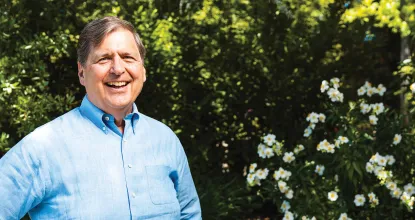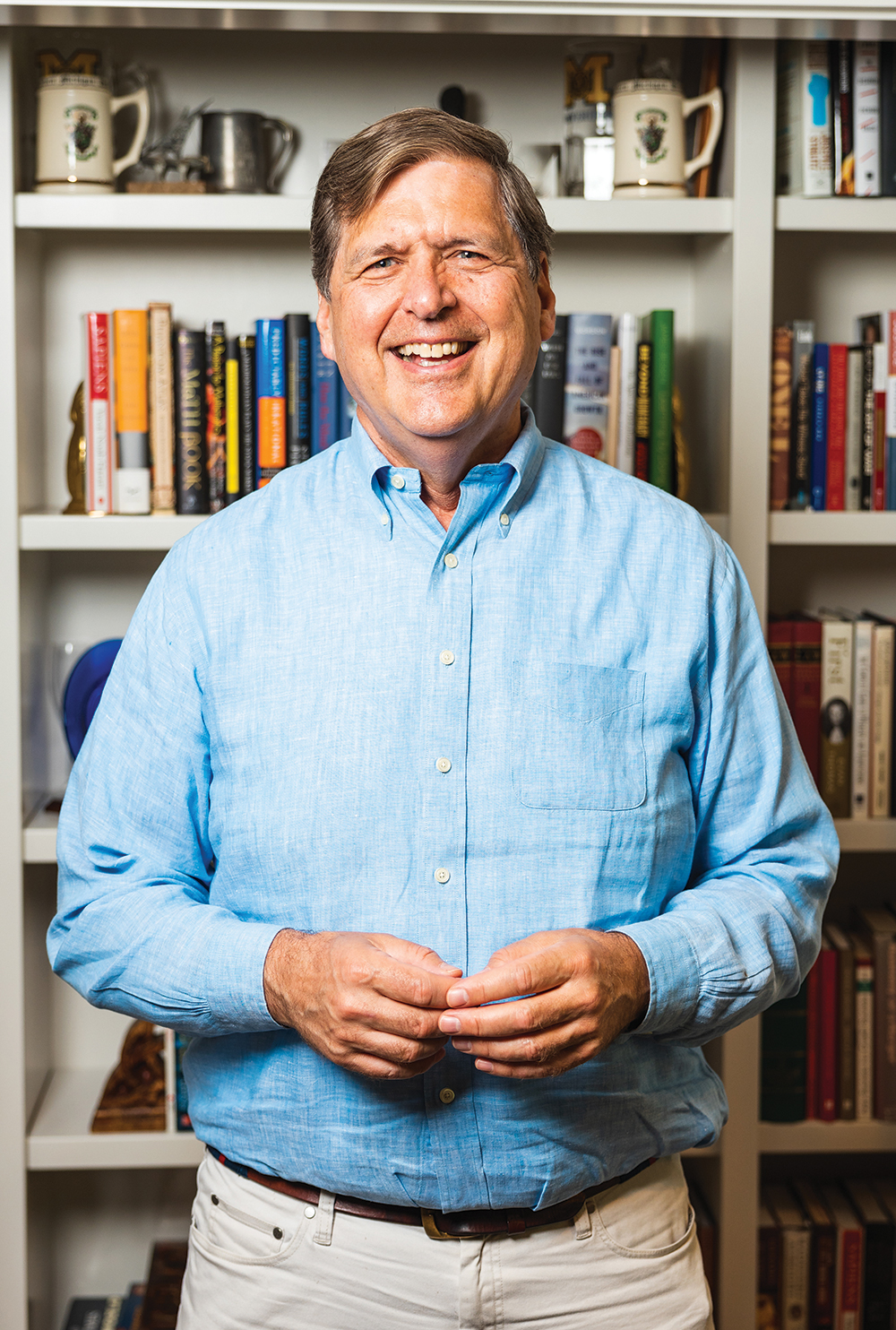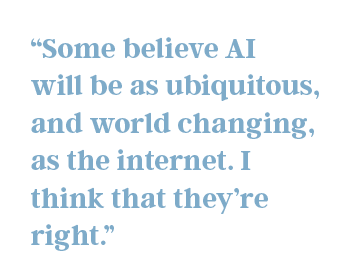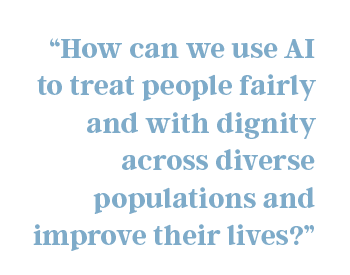
How Human Ingenuity Just Might Save the World (and create one we can’t yet imagine)
By Rebecca Tavernini '11 MA
 As an NMU student in the early 1970s, Jim Shaughnessy ’75 BS had a precious thing few others possessed: a key to the West Science Computer Lab. Late at night, he would unlock the door and spend hours alone with the university’s hulking mainframe computer, running his programs, free of having to compete with others for processing time. For a self-described campus geek, it was close to heaven. While he found writing code to be fun, it was still the early days in computing and the path to a career was unclear. So, inspired by the lawyers who, he said, “played a significant role in saving the Republic during Watergate,” he went on to get a law degree, launch one of the first internet businesses, and guide some of the top tech companies in the world: Lenovo, Digital Equipment Corp, Hewlett-Packard, Compaq, and digital travel pioneer Orbitz.
As an NMU student in the early 1970s, Jim Shaughnessy ’75 BS had a precious thing few others possessed: a key to the West Science Computer Lab. Late at night, he would unlock the door and spend hours alone with the university’s hulking mainframe computer, running his programs, free of having to compete with others for processing time. For a self-described campus geek, it was close to heaven. While he found writing code to be fun, it was still the early days in computing and the path to a career was unclear. So, inspired by the lawyers who, he said, “played a significant role in saving the Republic during Watergate,” he went on to get a law degree, launch one of the first internet businesses, and guide some of the top tech companies in the world: Lenovo, Digital Equipment Corp, Hewlett-Packard, Compaq, and digital travel pioneer Orbitz.
Shaughnessy most recently served as executive vice president for corporate affairs at Workday, named a Top 3 Most Innovative Company by Forbes. With approximately 13,000 employees, it’s a cloud-based finance, human resource, planning and analytics suite for companies looking for improved ways to predict, improve and manage these essential business tasks.
Lately, Shaughnessy has been focused on the ways that Artificial Intelligence (AI) and Machine Learning (ML) are transforming this space. Indeed, the dynamic duo of AI and ML has the potential to revolutionize much more than business practices. It is present already in many aspects of daily life, such as mapping apps, movie recommendations, facial recognition and car collision warning systems—just to name a few.
“Some believe AI will be as ubiquitous, and world changing, as the internet,” Shaughnessy said. “I think that they’re right.”
“Some think of AI as a discrete thing. But the right way to think about AI is that every place where code exists now, AI code will be implemented adjacent to it. All machines will eventually use AI to complete their tasks more efficiently and accurately. Some applications will be really sophisticated; others will be very practical.”
“We’re in a race to see if we can come up with solutions before irreversible changes to our planet occur.”
AI and ML enable continuous innovation. They can automate mundane, time-consuming functions and processes, identify patterns and detect anomalies. Paired with “augmented analytics,” they can more accurately than a human or spreadsheet predict and model what’s next, deriving insights from massive amounts of data.
Some of these tasks are certainly jobs that people now do. Shaughnessy noted research that predicts 30 percent of work will be transformed by 2030, meaning entire categories of jobs could be eliminated. “The pandemic has accelerated this transformation,” he said. “Relying on credentials, such as the presence of a four-year degree, isn’t good enough anymore. We need to focus on the specific skills people have, and use modern technology to help people gain and demonstrate those skills.” That could be via reimagined high schools, colleges or workplaces, or as is the case already, growing online courses such as those offered by Google.
The good news is, he said, “These same technologies that are transforming the world of work can also help provide solutions. Workday, for instance, has a feature that helps workers identify skills needed for a job, suggest learning modules to gain those skills, and validate those resulting credentials, which become part of their digital résumé.”
Transformation cannot happen, though, without establishing regulations that help ensure trust and transparency, human autonomy and privacy. Without such regulations, people will not trust new technologies. Shaughnessy has been a leading voice calling for new rules in the areas of AI and privacy. He notes the rapid pace of change in this area means that “we may have issues and decisions forced upon us that we are not prepared for.”
 Stepping back, Shaughnessy sees other life-changing technologies also emerging. He has been immersed in Walter Isaacson’s new book, The Code Breaker: Jennifer Doudna, Gene Editing, and the Future of the Human Race, which explores the development and potential of CRISPR, a groundbreaking method for genome editing, created by the Nobel-Prize winning team of Doudna and Germany’s Emmanuelle Charpentier. Shaughnessy sees the potential of this technology to help cure chronic illnesses like sickle-cell anemia. At the same time, ethical guardrails will be vital to ensure the technology isn’t misused.
Stepping back, Shaughnessy sees other life-changing technologies also emerging. He has been immersed in Walter Isaacson’s new book, The Code Breaker: Jennifer Doudna, Gene Editing, and the Future of the Human Race, which explores the development and potential of CRISPR, a groundbreaking method for genome editing, created by the Nobel-Prize winning team of Doudna and Germany’s Emmanuelle Charpentier. Shaughnessy sees the potential of this technology to help cure chronic illnesses like sickle-cell anemia. At the same time, ethical guardrails will be vital to ensure the technology isn’t misused.
“Climate is another huge area where we have to use tech to help in big and small ways,” he added. “There is much to be concerned about in climate and degradation of biodiversity. We’re in a race to see if we can come up with solutions before irreversible changes to our planet occur. Ultimately, this challenge will be addressed via the forward march of technology directed by humans, rather than by a return to pre-industrial methods.”
Taking a broad view, Shaughnessy retains confidence in the ability of technology to improve our world. “Innovators start with a quest for knowledge, wanting to understand how things work and spotting opportunities for improvement. They thrive on competition, creativity and building on each other’s ideas—working at odds and working together. This virtuous feedback loop is enhanced when we come at things from very different perspectives and fields,” he explained.
It may start with a small idea or simple innovation.
It may lead to a Big Hairy Audacious Goal (BHAG), the mot du jour in forward-thinking, throw-out-the-old-ways institutions.
 Shaughnessy throws out a few BHAGs of his own:
Shaughnessy throws out a few BHAGs of his own:
“Could we use CRISPR to genetically modify trees to mature faster and absorb more carbon?”
“Should social media and search companies be able to decide what is reality for hundreds of thousands of people? Two people can type in the same search words and get completely different results. That is tremendous power. Some kind of reform is appropriate and likely.”
“How can we use AI to treat people fairly and with dignity across diverse populations and improve their lives?”
Those audacious ideas may have started germinating at Northern, where he was, unknowingly at the time, setting the stage for a future career in high-tech. “I learned about algorithms in a business operations class, data structures in a math class, operations research in a business course. I was a teaching assistant for Bob Kulisheck, who taught me how to use a statistical package for analyzing political data. I was close with all of my professors and had the opportunity to really interact with them and learn what they were working on. That’s an experience that would have been harder to have at a larger school.”
Looking back and ahead at the same time, he said, “I’ve had a great career that married technology and law and an opportunity to be involved in some of the most interesting issues of our time.”